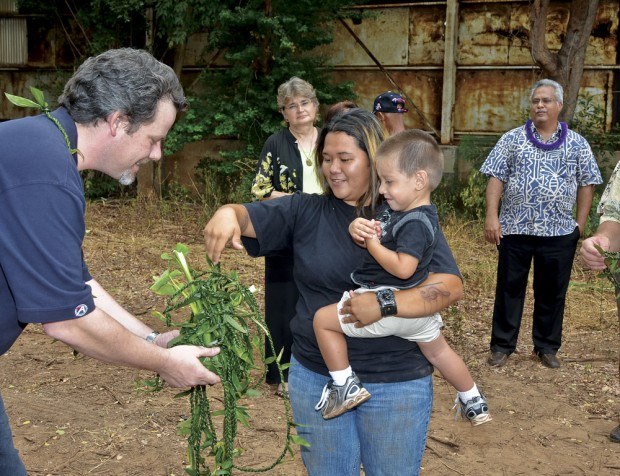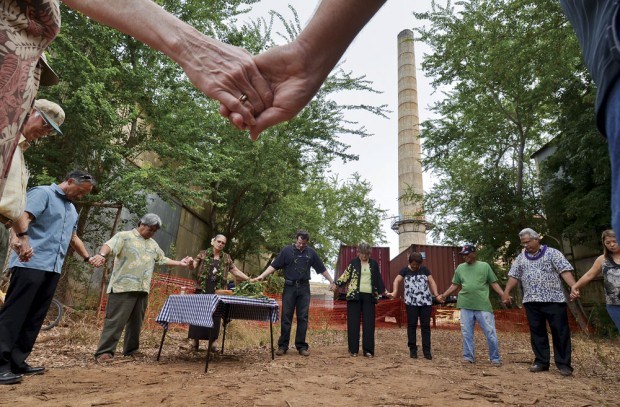KEKAHA — Tuesday was a time of thanks and aloha at the site of the former Kekaha Sugar Mill. Sounds of creaking, squeaking, clanging corrugated metal grinding against steel girders from the brisk tradewinds punctuated the words of Haku Aletha
KEKAHA — Tuesday was a time of thanks and aloha at the site of the former Kekaha Sugar Mill.
Sounds of creaking, squeaking, clanging corrugated metal grinding against steel girders from the brisk tradewinds punctuated the words of Haku Aletha Kaohi who officiated the special service. It was described by many as a blessing, but in reality, it was more of a funeral that brought closure to an era.
“I’m sad to see it go,” said Owen Moe, a Kekaha resident and former worker with Kekaha Sugar. “But life moves on.”
Kaohi, who labored until the wee hours of the morning to find the right words for the ceremony, said it was time to put one of Kaua‘i’s treasures to rest.
“I was the last manager here and I take it personally,” said Lyle Tabata, now the county’s deputy engineer. “Thank you, PAHIO (Resorts) for rescuing the land. My dad spent countless hours working here, and the men in the community became my father.”
Tabata, amid more clanging and groaning of agonized metal, said he remembers Saturday nights, the only time he had with his dad, and staying overnight at Second Ditch, fishing. He recalled the goody bags at Christmas where every kid got one, going to school during the pre-sunrise hours because he was a Junior Police Officer and seeing the bright flames of cane burning on the hillsides.
“I will cherish these memories forever,” he said.
Alfred Ruiz, retired after 35 years with the plantation, said between the Ruiz and Gonsalves families, there were so many members working at the plantation, the supervisors told him he hoped no one would die because the plantation would have to shut down for a couple of days.
“This is a very sore feeling,” said Dolly DeCosta, who attended both of the recent community meetings discussing the razing of the sugar mills. “But it has to come down because of the danger to the community. My granddaughter, Aiko Kajiwara, is part of the asbestos removal team and I’m proud of her and what she is doing.”
Kaohi said the event did not need cleansing, although she was ready for anyone who felt they needed it. She prepared a ho‘okupu comprised of key ingredients which would be placed at the mill site and removed with the final load.
“We ask for the safety of those who are faced with the task of taking this down,” she said. “We give praise for those who worked at the mill, we give thanks for what the mill did for Kekaha, and we pray for those who will take it apart.”
Forming the core of the ho‘okupu is the taro, the plant coming from Kaohi’s yard, and forming the basis for ‘ohana.
Grains of rice for the Japanese, Chinese and Filipino people; Irish potato for the supervisors, the comment drawing hushed laughter and grins from the audience; flour for the Portuguese and Puerto Ricans and the bread they baked; raw sugar and molasses which are products of the mill and for the mango seed; salt and a kukui nut, with prayers the oil inside will enlighten people’s lives.
These ingredients were wrapped in ti leaves and graced with lei from the guests with their blessings and spirit, the guests holding hands as Kaohi offered her blessing of aloha in a quiet pocket of shade as the wind rustled the branches of overgrown trees and the metal building offering its shadow as shade as its metallic wailing continues, the iconic stack standing lifeless, majestically in the morning sun.
A similar blessing for the Lihu‘e Sugar Mill is planned for today.



